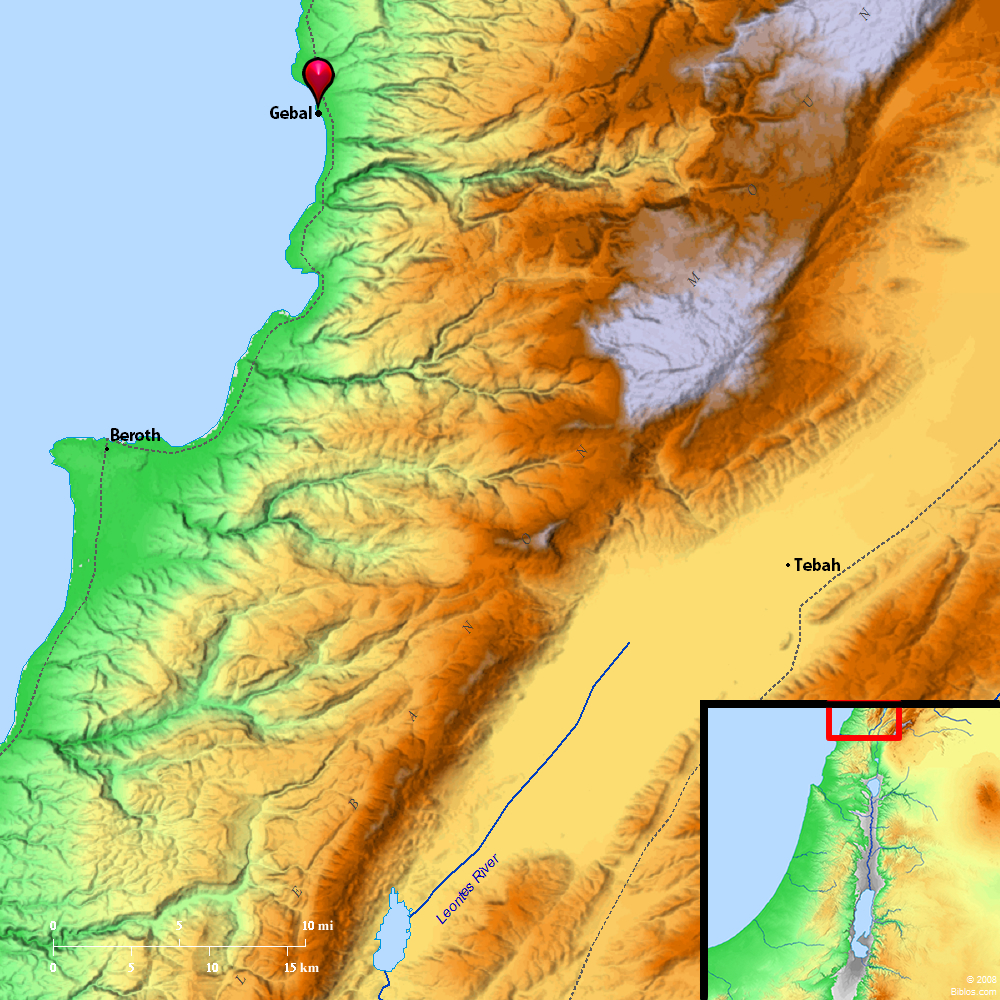Atlas

Gebal and surrounding region
Maps Created using Biblemapper 3.0Additional data from OpenBible.infoOccurrences
1 Kings 5:18 Solomon's builders and Hiram's builders and the Gebalites did fashion them, and prepared the timber and the stones to build the house.
Ezekiel 27:9 The old men of Gebal and the wise men of it were in you your repairers of ship seams: all the ships of the sea with their mariners were in you to deal in your merchandise.
Encyclopedia
GEBALge'-bal (gebhal, "border"; Bublos, and Biblos; Byblus, modern Jebeil):
(1) An ancient Phoenician city, situated on a bluff of the foothills of Lebanon, overlooking the Mediterranean. It was one of the principal seaports of Phoenicia, and had a small but good harbor for small ships. It lies in lat. 34 degrees 8', nearly, and about 4 miles North of the river Adonis (Nahr Ibrahim). It was regarded as a holy city by the ancients. Philo mentions the tradition that it was founded by Kronos, and was sacred to the worship of Beltis and, later, of Adonis, whose rites were celebrated yearly at the river of the same name and at its source in the mountain, at Apheca (see TAMMUZ). Gebal was the center of quite an extensive district, extending from the Eleutherus on the North to the Tamyras on the South, a distance of 60 or 70 miles along the coast. It is mentioned by Jos (13:5) as the land of the Gebalites (which see) (the King James Version "Giblites"), and the Gebalites are also mentioned in 1 Kings 5:18 (Hebrew 32) as aiding in the construction of Solomon's temple. The "elders" and the "wise men" of Gebal are among the workmen employed on Tyrian ships (Ezekiel 27:9 the American Revised Version, margin). The earliest mention of Gebal found in history is in the Tell el-Amarna Letters, which were composed in the first half of the 14th century B.C. It had become, in connection with all Phoenicia, a dependency of Egypt in the days of Thothmes III and was under Egyptian governors, but, in the reign of Amenhotep IV (Ikhnaton), the Hittites and Amorites from the North and Khabiri from the South attacked the territory of Gebal, and its governor wrote letters to Amenhotep, calling for help. There are over 60 of these, describing the desperate condition of the city and of its governor, Ribaddi, who was expelled and took refuge in Beirut, but afterward regained his capital only to be besieged and lose all his dependencies, and finally to fall into the hands of the enemy. Gebal afterward became independent, as is shown by the records of Ramses IX (1442-1423 B.C.) and of Ramses XII, for its king retained the emissaries of the former 17 years in captivity, and treated a trusted agent of the latter with scant civility. Its king at this time was Zakkar-Baal, and kings of Gebal are mentioned in the Assyrian records, one paying tribute to Ashurnazir-pal (circa 887 B.C.) and another to Sennacherib (705-680). The latter king was Uru-melek, and kings of Gebal are mentioned in connection with other Phoenician cities under Persian rule. The city submitted to Alexander the Great without opposition, and furnished a fleet to aid him in the siege of Tyre (332). Strabo refers to it as a town of note in the days of Pompey (xvi.2, 17), and it is frequently mentioned in Phoenician (CIS, 1) and Assyrian inscriptions in the forms Gubal and Gubli (COT, I, 174).
(2) (gebhal; Gobolitis): A district Southeast of the Dead Sea, which is referred to in Psalm 83:7 (Hebrew 8) in connection with Moab, Ammon, Amalek and others, as making a covenant together against Israel (compare 1 Maccabees 5). Robinson (BR, II, 154) found the name Jebal still applied to this region, and Josephus (Ant., II, i, 2) speaks of a Gebalitis as forming part of Idumaea. It is a hilly region, as the modern name signifies, and includes the towns of Shobek and Tolfieh.
H. Porter
GE'BAL, now Jebeil, 17 ms. n.n.e. of Beyrout; a village of several hundred inhabitants near the shore of the Mediterranean with many ruins and some hewn stones each 20 ft. long.
Strong's Hebrew
H1380: Gebala city in Phoenicia




